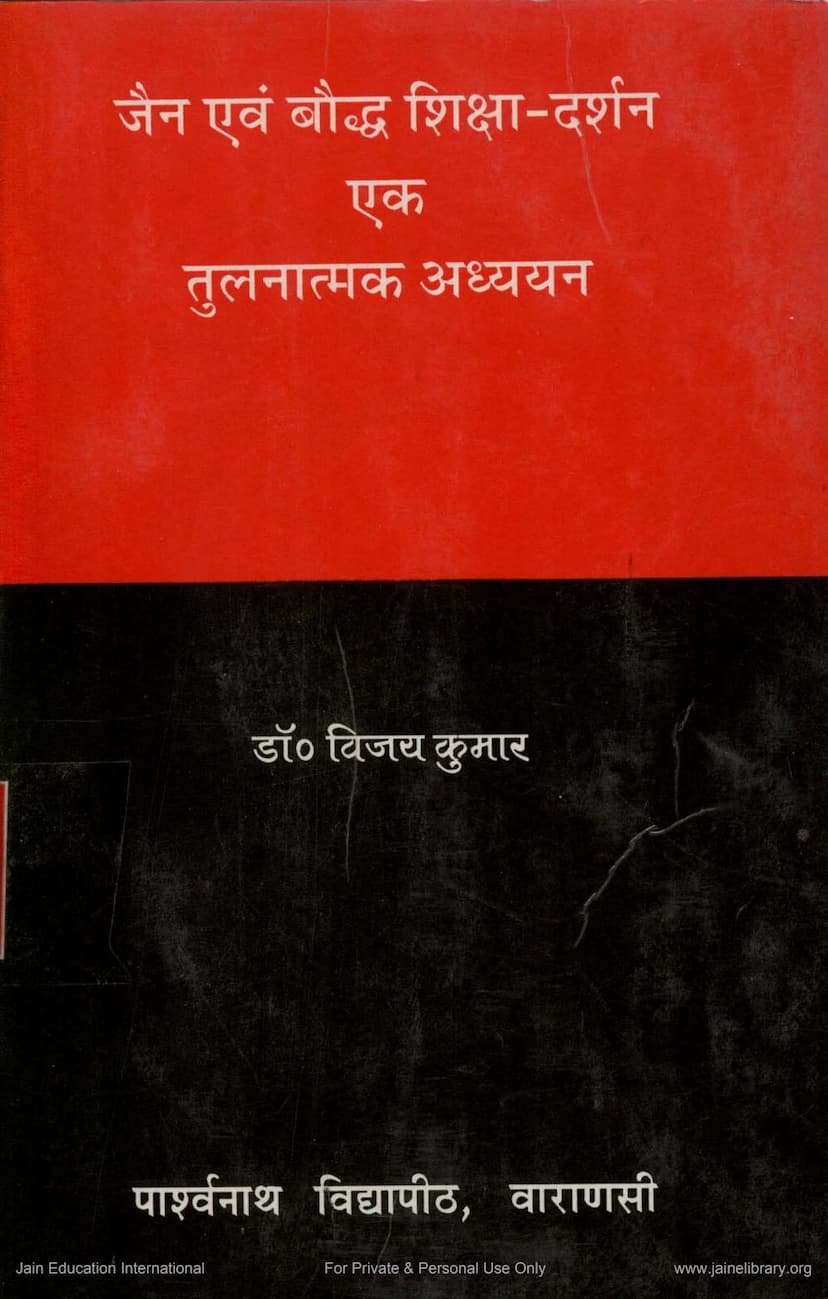Jain Evam Bauddh Shiksha Darshan Ek Tulnatmak Adhyayana
Added to library: September 2, 2025

Summary
Here's a comprehensive summary of the Jain text "Jain evam Bauddh Shiksha Darshan Ek Tulnatmak Adhyayana" (A Comparative Study of Jain and Buddhist Educational Philosophy) by Dr. Vijay Kumar, published by Parshwanath Shodhpith Varanasi:
This book offers a comparative analysis of the educational philosophies of Jainism and Buddhism, two prominent Shraman (ascetic) traditions that emerged in ancient India. The author, Dr. Vijay Kumar, a lecturer in Philosophy at Parshwanath Vidyapeeth, Varanasi, aims to highlight the relevance of these ancient educational systems for addressing contemporary educational challenges, particularly the need for spiritual and moral values in education.
The book is structured into eight chapters:
Chapter 1: Education Philosophy: A General Introduction This chapter lays the groundwork by defining education, discussing its literal and philosophical meanings, and exploring its intrinsic relationship with life and philosophy. It also touches upon the inherent problems within the educational system. The author contrasts the Western emphasis on materialistic education with the Indian focus on spiritual development, while acknowledging that Indian education also incorporates worldly aspects.
Chapter 2: Jain and Buddhist Philosophy and Literature This chapter provides an overview of Jain and Buddhist religions and their philosophical underpinnings. It delves into their respective foundational texts and literature, highlighting their historical context and independent development. The chapter also touches upon the historical debate regarding the relationship between Jainism and Buddhism, asserting Jainism's distinct and ancient origins. Key philosophical concepts like Ahimsa (non-violence), Anekantavada (non-absolutism), and Karma-vada (theory of action) are introduced for Jainism, and Pratītyasamutpāda (dependent origination), Kshanabhangavada (momentariness), and Anatmanavada (non-self) for Buddhism.
Chapter 3: Objectives and Subject Matter of Jain and Buddhist Education This chapter examines the primary goals and curriculum of education in both traditions. It divides education into spiritual and secular (or worldly) aspects.
- Spiritual Education: In Jainism, this focuses on the Triratnas (Three Jewels) – Right Faith, Right Knowledge, and Right Conduct – and the Panchamahavratas (Five Great Vows). In Buddhism, it emphasizes the Four Noble Truths and the Eightfold Path. The ultimate aim in both is liberation or Nirvana.
- Secular Education: This covers various arts and contemporary subjects deemed necessary for worldly life and livelihood. The chapter discusses the 72 arts for men and 64 for women in Jain tradition, and the 96 arts mentioned in Buddhist literature, noting the inclusion of secular subjects like mathematics, literature, and various crafts.
Chapter 4: Educational Methods This chapter details the pedagogical approaches employed by both Jain and Buddhist traditions.
- Jain Methods: The text outlines nine methods, including Patha-vidhi (lesson recitation), Prashnottara-vidhi (question-answer method), Shastrartha-vidhi (debate method), Upadesha-vidhi (lecture method), Naya-vidhi (analytical reasoning), Anuyogadvara-vidhi (discourse analysis), Upakrama/Upodghata-vidhi (introduction/preamble), Panchanga-vidhi (five-part study), and Shravana-vidhi (listening).
- Buddhist Methods: The chapter lists seven methods, including Patha-vidhi, Shastrartha-vidhi, Upama-vidhi (analogy method), Prashnottara-vidhi, Upadesha-vidhi, Pramana-vidhi (means of valid knowledge), and Swadhyaya-vidhi (self-study). The author notes the prevalence of debate and analogy in Buddhist pedagogy.
Chapter 5: Teacher's Qualifications and Responsibilities This chapter emphasizes the pivotal role of the teacher in both traditions, defining the ideal guru (acharya in Jainism, upadhyaya/acharya in Buddhism). It outlines the extensive qualifications and responsibilities, including profound knowledge of scriptures, ethical conduct, profound wisdom, mastery of various arts and sciences, and the ability to inspire and guide disciples. The chapter details the 36 virtues for Jain acharyas and the multifaceted duties of Buddhist upadhyayas, highlighting their role as exemplary figures and spiritual guides.
Chapter 6: Student's Qualifications and Responsibilities This chapter focuses on the qualities and duties expected of the student (shishy in Jainism, shishy/shraman/shramaner in Buddhism). It emphasizes virtues like discipline, humility, obedience, respect for the teacher, intellectual curiosity, and ethical conduct. The text contrasts the characteristics of the 'vinita' (disciplined) student with the 'avineeta' (undisciplined) student, elaborating on the positive and negative consequences of each. It also details the various stages of education and associated rituals like Upanayana and Vratachara in Jainism, and Pravrajya and Upasampada in Buddhism.
Chapter 7: Teacher-Student Relationship and Disciplinary Measures This chapter explores the deep and affectionate bond between teachers and students in both traditions. It highlights the father-son-like relationship and the mutual respect that characterized these interactions. The chapter also delves into the disciplinary measures implemented, ranging from mild correction to more severe forms of penance and expulsion, depending on the nature and severity of the offense. It details the ten types of penance in Jainism and the classification of offenses into Parajika, Sanghadisesa, Nissaggiya Pacittiya, Pacittiya, Patidesaniya, Thullaccaya, Dukkrta, and Dubbhasita in Buddhism.
Chapter 8: Conclusion The concluding chapter summarizes the key findings and offers a reflection on the relevance of Jain and Buddhist educational philosophies in the modern context. The author argues that while these ancient systems were deeply rooted in spiritual and moral development, they also incorporated secular knowledge and skills necessary for worldly life. Dr. Kumar emphasizes that modern education, often lacking in ethical and spiritual dimensions, can greatly benefit from integrating the core values and pedagogical principles of Jainism and Buddhism, such as non-violence, self-control, intellectual rigor, and the pursuit of wisdom and liberation. The chapter also touches upon the need for adapting these ancient systems to contemporary societal needs and educational structures.
In essence, "Jain evam Bauddh Shiksha Darshan Ek Tulnatmak Adhyayana" provides a thorough and insightful comparative study of the educational philosophies of Jainism and Buddhism, highlighting their shared emphasis on holistic development and their potential to contribute to a more meaningful and value-based education system today.